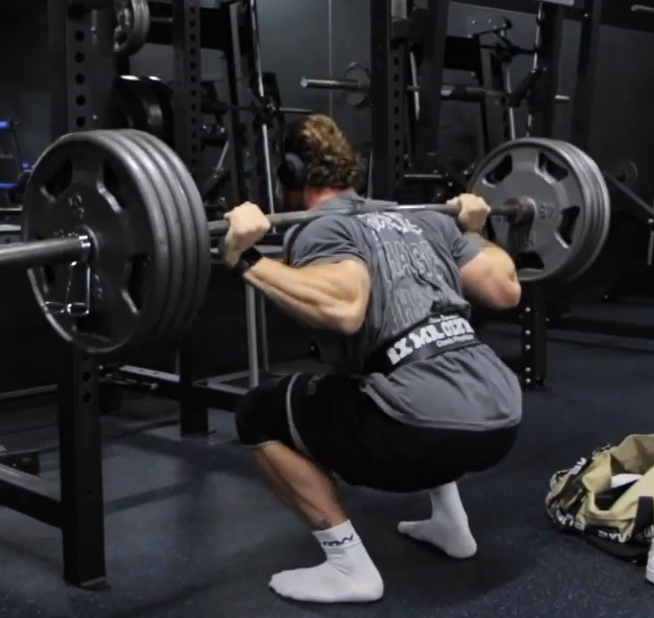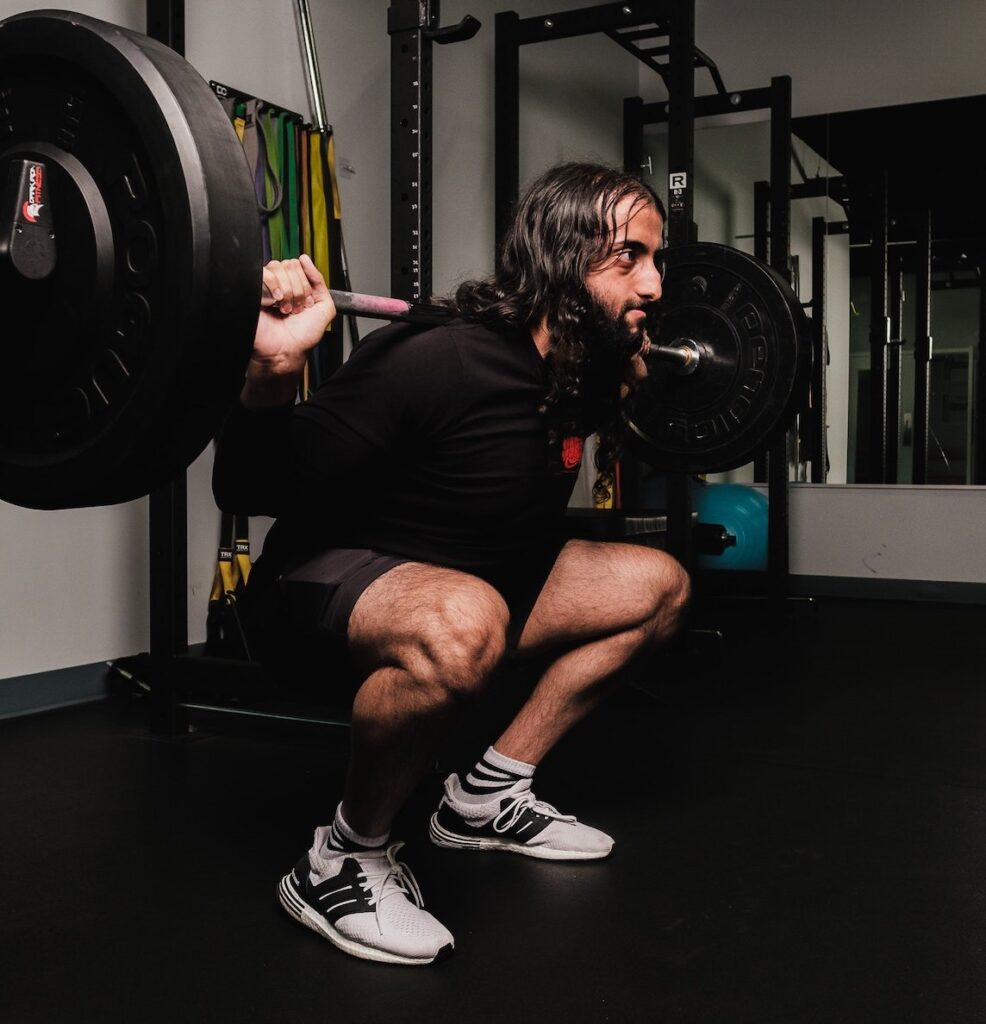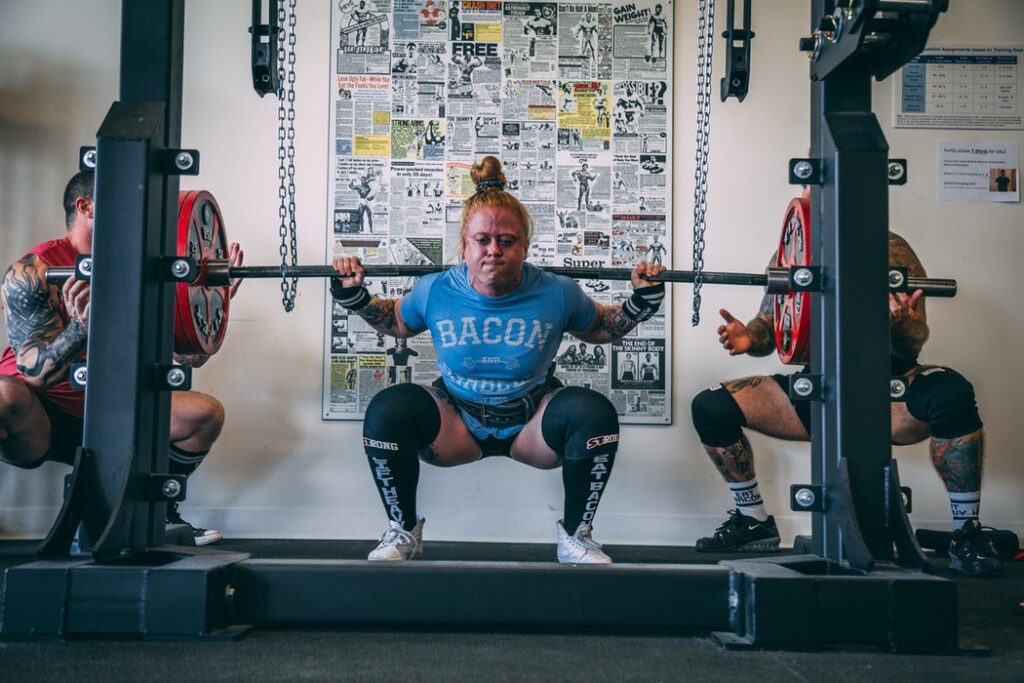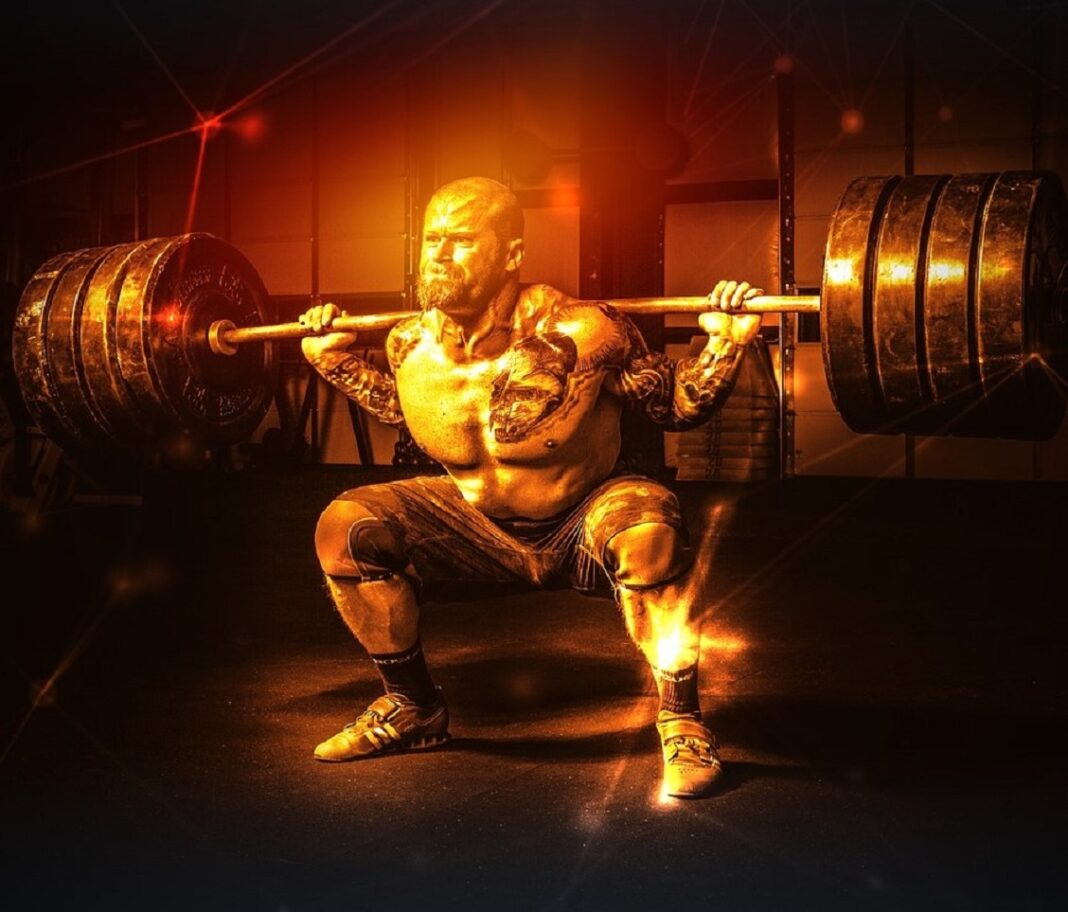You may think you know how to squat correctly. But you probably don’t. When it comes to squatting, there are a lot of variables that make the difference between flawless and suboptimal. We’re going to focus foremost on squatting for lower body hypertrophy and not pure strength, though by following our steps you’ll be in the best position to quickly improve both. So let’s get squatting—the right way.
1. CHOOSE YOUR TOOLS
Footwear
You don’t have to wear shoes when squatting. You can go barefoot (as Arnold did) or wear only socks (as popular bodybuilder Chris Bumstead does) or wear “barefoot” glove-like shoes. Doing so will help you better grip the floor, spread your toes for a stronger position, and improve ankle mobility.

Wearing shoes will provide arch support, more stability, and may provide more floor friction. For most people, typical gym shoes will suffice. However, shoes or boots with elevated heels can help you focus more tension on the quads, especially if you otherwise have difficulty staying upright in the low position.
Knee Wraps and Sleeves
Wearing knee wraps or sleeves is a personal choice. If you have knee pain, you shouldn’t be squatting at all, but wraps or sleeves can help support your knees and thus prevent future pains. For bodybuilders, we recommend sleeves over wraps, simply because they’re much easier to use. However, for maximum support on heavy lifts, wraps are best.
Belt
We recommend you wear a lifting belt for at least your heaviest sets of squats. In addition to supporting your spinal erectors, a cinched belt will pull your waist in and remind you to keep your upper body tense.
Barbell
If your gym has a barbell that has a strip of knurling in the center, that’s a squat bar, even if it’s stranded far from the squat rack. Use it. The center knurling will subtly bite into your shirt and traps to help you keep the bar steady.
2. WHERE TO SQUAT
Squat in a squat rack or power rack. The bar should rest in the supports at just a little lower than shoulder-height so you can comfortably lift it off by standing straight.
Position the safety bars so they’re just below the depth the bar is going to go. Many people leave the safeties too low, as if they’re only an obstruction to avoid. Even if you have a spotter hugging your waist and especially if you don’t, the safety bars can be your best friend if you fail and need to bail. However, that’s only true if they’re high enough that you can set the bar on them without folding yourself up like a lawn chair.
3. GET A GRIP
Generally, your grip should be approximately the same width you take when you bench press. If your shoulders are so tight that this grip is uncomfortable, you can go wider, just understand that the wider your grip the less stable the bar will be, and the less stable the bar is the less strong your squat will be. You may have seen people squatting with their hands against the collars or even over the edge of the plates, but this is not recommended for your heaviest sets.
Once you’ve set your grip, squeeze the bar, and keep doing so throughout the set. This helps you contract your shoulders and back.
4. POSITION THE BAR
It’s a given that the bar needs to be properly centered. Whether to place it high or low isn’t so obvious. If you go high, it’ll be against your traps at the top of your shoulders. If it’s low, it’ll be about two inches lower than high, resting on the top of your back.
Traditionally, bodybuilders squat high-bar, because this keeps them more upright and involves the quads more. Powerlifters squat low-bar, which a greater forward lean. However, you need to find which style works best for your bodytype. Taller bodybuilders may need to hold the bar lower in order to get low. Also note that a low-bar position will allow you to squat 10-20% more by incorporating more force from the glutes and hamstrings.
5. TIGHTEN UP
Squeeze your shoulder blades to tighten your upper back. Raise your chest up. Consciously doing this will keep your torso upright and stiff, which will, in turn, help you maintain proper form and keep the bar locked in place.
6. UNRACK IT
Raise the bar off the supports by standing straight, and then take a step backwards.
7. TAKE A STANCE
Try a shoulder-width stance. If you can’t stay reasonably upright and get to parallel, widen your stance slightly on subsequent sets until you find the right position for you and your body type. Generally, if you have longer legs, you’ll need a wider stance.

Your toes should be angled out at 30 degrees. This means if straight ahead is 12:00, your right foot should be at 2:00 and the left one at 10:00. As with heeled shoes, you may want to elevate your heels slightly with a block or mat to help you stay more upright. But for most people, your feet should be flat on the floor throughout the set.
8. FACE FORWARD
Some squatters look up to help them keep their torsos upright. Doing so is certainly superior to looking down (never do that with a bar on your back). However, it’s best to look straight ahead. This is the safest position for your neck, and the best way to keep your back tensed.
The middle of a heavy set is no time to alter your form, so ignore mirrors after your warmup sets. Don’t close your eyes, but don’t let your reflection affect your form. To analyze your technique, have someone record your entire set from the side and watch between sets or post-workout.
9. BREATHE
There are two schools of thought on breathing while squatting. We’ll call the first the just-do-it school and the second the hold-it school. Just-do-it prescribes that you forget about it and breathe as necessary throughout each set. Therefore, you have one less thing to focus on.
The hold-it school prescribes that you inhale just before descending, hold it, and exhale either when the rep is done or as it’s being completed (or if you hit a sticking point). The logic behind hold-it is that it’s easier to keep your torso tight if you’re not breathing. Each method has its advantages. Experiment to see which way works best for you and your squat.
10. GET DOWN
The shortest distance for the bar to travel is a straight line. This means it needs to follow a descending path as close to vertical as possible. However, this doesn’t mean that your back should stay vertical. Your back will lean forward as your hips go backwards. In this way, you’ll be folding slightly, and that’ll keep the bar descending straight down. Ideally, the barbell should stay over your mid-foot throughout each rep. How much you lean forward is somewhat determined by your height. Taller squatters with longer legs will need to bring their hips farther back and their chest farther forward.
Your knees should come out over your feet, which are themselves angled outward, while simultaneously your hips travel backwards. Your knees will stop moving forward when the bar is approximately halfway down, but they’ll keep bending as you continue lowering your hips. Meanwhile, your lower back should maintain its natural arch but not accentuate it.
11. BOTTOM OUT
How far down to go is a topic of some debate. Bodybuilders like Tom Platz, who had the roundest wheels of all time, used to go glutes-to-ankles, as low as they could go without digging a hole in the floor. Others have built world-class legs while never hitting parallel. Generally, however, the zone where your femurs are just below parallel to the floor is the target. This marks an official squat in powerlifting, and can be considered the halfway point of a full rep in bodybuilding.

Below parallel is also the hardest part of a squat to get to and get out of. That’s the reason it’s called “the hole” and why so many squatters avoid it. But its difficulty is precisely why you should go there. Science shows by breaking parallel you can be assured you’re getting the maximum muscle stimulation, especially in the glutes and thigh adductors, out of every set.
But how exactly can you be sure you’ve gone deep enough without an X-ray machine to see the angle of your femurs? You can have someone watch and/or record your squats from the side to monitor this. You can also practice by setting a box just below parallel and squatting down to it. After a while, you’ll come to feel when you’ve gone low enough.
12. GET UP
Getting out of “the hole” is the hard part. Never dawdle there. As soon as you hit it, get out of it. Bring your hips up and unfold your knees simultaneously. Remember to stay tight. Keep your chest up, your spine only slightly arched, and your upper back constricted. As you rise and unfold, your knees will travel backwards and your hips will go forward, but the barbell should stay over your mid-foot and traveling perfectly vertical the entire time.
After about the halfway point, the remainder should be smooth sailing. But don’t get sloppy. Stay tight and let your knees, hips, and upper body straighten simultaneously. Some weight-trainers avoid straightening their legs fully at the top of reps in order to keep constant tension on their legs, but the benefits of this are minimal since there’s so little tension near the top. Lock out very briefly to complete a full squat. Then start over.
HOW TO SQUAT: WRAPPING UP
Practice makes perfect only if you practice perfectly. Each rep should be precisely like the one before. With experience you’ll get into a groove, so that correct form will come naturally and you’ll hit your target depth on rep after rep, rhythmically, like a piston rising up and down.
Further Reading
Different Muscle Growth from Different Squat Depths
















































